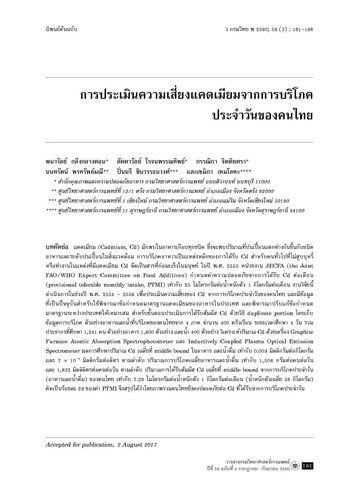การประเมินความเสี่ยงแคดเมียมจากการบริโภคประจำวันของคนไทย
คำสำคัญ:
risk assessment of cadmium, dietary exposureบทคัดย่อ
แคดเมียม (Cadmium, Cd) มักพบในอาหารเกือบทุกชนิด ซึ่งจะพบปริมาณที่ปนเปื้อนแตกต่างกันขึ้นกับชนิดอาหารและระดับปนเปื้อนในสิ่งแวดล้อม การบริโภคอาหารเป็นแหล่งหลักของการได้รับ Cd สำหรับคนทั่วไปที่ไม่สูบบุหรี่หรือทำงานในแหล่งที่มีแคดเมียม Cd จัดเป็นสารที่ก่อมะเร็งในมนุษย์ ในปี พ.ศ. 2553 หน่วยงาน JECFA (the Joint FAO/WHO Expert Committee on Food Additives) กำหนดค่าความปลอดภัยจากการได้รับ Cd ต่อเดือน (provisional tolerable monthly intake, PTMI) เท่ากับ 25 ไมโครกรัมต่อน้ำหนักตัว 1 กิโลกรัมต่อเดือน งานวิจัยนี้ดำเนินการในช่วงปี พ.ศ. 2554 - 2556 เพื่อประเมินความเสี่ยงของ Cd จากการบริโภคประจำวันของคนไทย และมีข้อมูลที่เป็นปัจจุบันสำหรับใช้พิจารณาข้อกำหนดมาตรฐานแคดเมียมของอาหารในประเทศ และพิจารณาปรับแก้ข้อกำหนดมาตรฐานระหว่างประเทศให้เหมาะสม สำหรับขั้นตอนประเมินการได้รับสัมผัส Cd ด้วยวิธี duplicate portion โดยเก็บข้อมูลการบริโภค ตัวอย่างอาหารและน้ำที่บริโภคของคนไทยจาก 4 ภาค จำนวน 400 ครัวเรือน ระยะเวลาศึกษา 4 วัน รวมประชากรที่ศึกษา 1,241 คน ตัวอย่างอาหาร 1,600 ตัวอย่าง และน้ำ 400 ตัวอย่าง วิเคราะห์ปริมาณ Cd ด้วยเครื่อง Graphite Furnace Atomic Absorption Spectrophotometer และ Inductively Coupled Plasma Optical Emission Spectrometer ผลการศึกษาปริมาณ Cd เฉลี่ยที่ middle bound ในอาหาร และน้ำดื่ม เท่ากับ 0.009 มิลลิกรัมต่อกิโลกรัม และ 7 × 10-4 มิลลิกรัมต่อลิตร ตามลำดับ ปริมาณการบริโภคเฉลี่ยอาหารและน้ำดื่ม เท่ากับ 1,506 กรัมต่อคนต่อวัน และ 1,832 มิลลิลิตรต่อคนต่อวัน ตามลำดับ ปริมาณการได้รับสัมผัส Cd เฉลี่ยที่ middle bound จากการบริโภคประจำวัน (อาหารและน้ำดื่ม) ของคนไทย เท่ากับ 7.29 ไมโครกรัมต่อน้ำหนักตัว 1 กิโลกรัมต่อเดือน (น้ำหนักตัวเฉลี่ย 58 กิโลกรัม) คิดเป็นร้อยละ 29 ของค่า PTMI จึงสรุปได้ว่าโดยภาพรวมคนไทยยังคงปลอดภัยต่อ Cd ที่ได้รับจากการบริโภคประจำวัน
เอกสารอ้างอิง
Jarup L. Hazards of heavy metal contamination. Br Med Bull 2003; 68: 167-82.
European Food Safety Authority. Cadmium dietary exposure in the European population. EFSA Journal [online]. 2012 [cited 2016 Nov 15]; 10(1): [37 pp]. Available from: URL: https://onlinelibrary.wiley.com/doi/10.2903/j.efsa.2012.2551/epdf.
United Nations Environment Programme, Chemicals Branch, DTIE. Final review of scientific information on cadmium [online]. 2010 [cited 2016 Nov 15]. Available from: URL: https://drustage.unep.org/chemicalsandwaste/sites/unep.org.chemicalsandwaste/files/publications/GAELP_PUB_UNEP_GC26_INF_11_Add_2_Final_UNEP_Cadmium_review_and_apppendix_Dec_2010.pdf.
IPCS INCHEM. Environmental health criteria 134, cadmium. Geneva: World Health Organization; 1992. [cited 2016 Sep 1]. Available from: URL: https://www.inchem.org/documents/ehc/ehc/ehc134.htm.
European Food Safety Authority. Scientific opinion cadmium in food scientific opinion of the panel on contaminants in the food chain. The EFSA Journal [Internet]. 2009 [cited 2016 Sep 1]; 980: 1-139. Available from: URL: https://www.efsa.europa.eu/sites/default/files/scientific_output/files/main_documents/980.pdf.
Godt J, Scheidig F, Grosse-Siestrup C, Esche V, Brandenburg P, Reich A, et al. The toxicity of cadmium and resulting hazards for human health. J Occup Med Toxicol [online]. 2006 [cited 2016 August 11]; 1(22): [6 screens]. Available from: URL: https://www.ncbi.nlm.nih.gov/pmc/articles/PMC1578573/pdf/1745-6673-1-22.pdf.
Jarup L, Akesson A. Current status of cadmium as an environmental health problem. Toxicol Appl Pharmacol 2009; 238(3): 201-8.
World Health Organization, Food and Agriculture Organization of the United Nations. Joint FAO/WHO food standards programme, Discussion paper on cadmium (CX/FAC 99/21). The Hague, Netherlands; 22-26 March 1999.
U.S. Department of Health and Human Services. Toxicological profile for cadmium. Atlanta, Georgia: Agency for Toxic Substance and Disease Registry; 2012.
Norwegian Scienticfic Committee for Food Safety. Risk assessment of dietary cadmium exposure in the Norwegian population. [online]. 2015 [cited 2016 Sep 1]; [101 screens]. Available from: URL: https://www.vkm.no/dav/07cfa5d365.pdf
Olsson IM, Bensryd I, Lundh T, Ottosson H, Skerfving S, Oskarsson A. Cadmium in blood and urine-impact of sex, age, dietary intake, iron status, and former smoking-association of renal effects. Environ Health Perspect 2002; 110(12): 1185-90.
International Agency for Research on Cancer WHO. IARC Monographs on the evaluation of carcinogenic risk to humans. [online]. [cited 2016 Sep 1]. Available from: URL: https://monographs.iarc.fr/ENG/Classification/latest_classif.php
WHO. Evaluations of the joint FAO/WHO expert committee on food additives (JECFA), Cadmium. [online]. 2013 [cited 2016 Sep 1]; [1 screens]. Available from: URL: https://apps.who.int/food-additives-contaminants-jecfa-database/chemical.aspx?chemID=1376
มยุรี อุรารุ่งโรจน์, ประกาย บริบูรณ์, พนาวัลย์ กลึงกลางดอน. การศึกษาปริมาณโลหะเป็นพิษในอาหารที่คนไทยบริโภคต่อวัน ระหว่าง พ.ศ. 2542-2544. ว กรมวิทย พ 2548; 47(4): 234-47.
ประกาศกระทรวงสาธารณสุข ฉบับที่ 98 (พ.ศ. 2529) เรื่อง มาตรฐานอาหารที่มีสารปนเปื้อน. ราชกิจจานุเบกษา เล่มที่ 103 ตอนที่ 23 ง ฉบับพิเศษ (วันที่ 16 กุมภาพันธ์ 2529)
World Health Organization. Application of risk analysis to food standard issue. Report of the joint FAO/WHO expert consultation. Geneva, Switzerland. 13-17 March 1995 [online]. [cited 2016 Sep 1]; [45 screens]. Available from: URL: https://apps.who.int/iris/bitstream/10665/58913/1/WHO_FNU_FOS_95.3.pdf
World Health Organization. Guideline for the study of dietary intake of chemical contaminants. Geneva: World Health Organization; 1985.
AOAC International. AOAC official method 999.10 lead, cadmium, zinc, copper and iron in foods. In: Horwitz W, Latimer GW, editors. Official method of analysis of AOAC international. 18th ed. Maryland: AOAC International; 2011. Chapter 9 p.16-19.
American Public Health Association. Standard methods for the examination of water and wastewater. 22nd ed. Maryland: American Public Health Association; 2012.
สำนักมาตรฐานสินค้าเกษตรและอาหารแห่งชาติ. ข้อมูลการบริโภคอาหารของประเทศไทย. [ออนไลน์]. 2559 [สืบค้น 1 ก.พ. 2560]. เข้าถึงได้จาก : URL: https://www.acfs.go.th/document/download_document/FCDT.pdf
Liu P, Wang CN, Song XY, Wu YN. Dietary intake of lead and cadmium by children and adults-result calculated from dietary recall and available lead/cadmium level in food in comparison to result from food duplicate diet method. Int J Hyg Environ Health 2010; 213(6): 450-7.
Lee HS, Cho YH, Park SO, Kye SH, Kim BH, Hahm TS, el al. Dietary exposure of the Korean population to arsenic, cadmium, lead and mercury. J Food Comp Anal 2006; 19: S31-7.
Arnich N, Sirot V, Riviere G, Jean J, Noel L, Guerin T, et al. Dietary exposure to trace elements and health risk assessment in the 2nd French total diet study. Food Chem Toxicol 2012; 50(7): 2432-49.
Sand S, Becker W. Assessment of dietary cadmium exposure in Sweden and population health concern including scenario analysis. Food Chem Toxicol 2012; 50(3-4): 536-44.

ดาวน์โหลด
เผยแพร่แล้ว
รูปแบบการอ้างอิง
ฉบับ
ประเภทบทความ
สัญญาอนุญาต

อนุญาตภายใต้เงื่อนไข Creative Commons Attribution-NonCommercial-NoDerivatives 4.0 International License.



